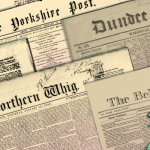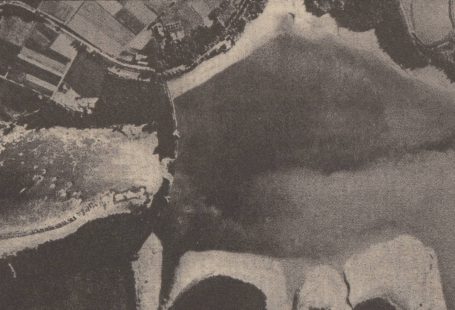This week’s episode of Who Do You Think You Are? with Fearne Cotton delved into the difficult subject of conscientious objectors during World War I. The episode also exposed the precarious nature of success in nineteenth century Britain. The episode made extensive use of newspapers, and as always we have taken the story further with our own investigations into the topics covered using the newspapers in the Archive.
Fearne began her journey by looking to her Welsh roots. As a young man in the 1910s her Great-Grandfather Evan Meredith worked in the Six Bells Colliery. The mentions of the mine in the newspapers attest to the physically hard and dangerous work of coal-mining. There were numerous accidents in the mine over the years. Miners were tough hardy men, unafraid of hard work and harsh conditions.
Conscription & Conscientious Objectors

As the episode explained, coal-mining was, for much of the First World War, considered essential war work and the men employed there were exempted from the first waves of conscription. This policy changed late in the war and a ‘comb-out’ was put into effect. A percentage of men from the mines, suited to service, were selected. Evan Meredith was selected and declared his refusal to serve on the grounds that he was a conscientious objector. For this he was imprisoned twice. Conscientious objectors were an object of much debate in the press. Many of the articles can make for uncomfortable reading.
On an occasion like the present the conscientious objector is man of mystery. He is a man who avails himself of the protection the State but is not willing take his share in protecting the State when the State is menaced by external attack. He and his wife and family are protected by the British army and navy from murder and outrage the foreign foe. but he will not take share in the act of protection.

After the war, when men such as Evan were still imprisoned, there was agitation to have them released so as they could return to work and re-build a nation who had lost so many of its young men. Evan himself organised a hunger strike, in protest of his continued imprisonment, and was released due to ill-health. After this period he retrained and became a successful pharmacist. The legislation under which he was released was nick-named the ‘cat and mouse act’ as the government released their prisoners only to recapture them again. As shown in the image here the act was originally created to combat the organisation of hunger strikes by Suffragettes and was considered a resounding success (click on the image to enlarge and read).

A Self-Made Medical Man
Having satisfied her curiosity regarding her paternal line Fearne turned to her maternal line and was surprised that family could be traced back to Ireland. William Gilmour from Garvagh proved an intriguing character. In his early twenties he extracted himself from rural Garvagh and set himself up as an apothecary (chemist). Soon he was appointed to a dispensary in Liverpool.

However he appears to have been a restless and ambitious soul and Fearne next discovered that he had take a commission aboard a ship heading to the battlefields of the Crimea. A notice congratulating him on his appointment appeared in his hometown newspaper, the Coleraine Chronicle. Notices such as these were excellent publicity for an ambitious man.
We understand that Dr. Gilmour, of this town, has been appointed Medical Superintendent of the screw steam-ship Great Britain, which has been chartered Government as a transport to convey troops to the Crimea, and bring back invalids. She is to sail from Liverpool on Monday with soldiers, 63 officers, and 23 horses. We wish Dr. Gilmour every success his new and arduous sphere of duty.


Declaring himself an MD despite not having a formal qualification he was charged with the care of civilians and soldiers. He served with distinction and returned to England in September of 1855. He received several testimonials which were printed in the newspapers for all to see. His crowning moment (if you will pardon the pun!) came when he dined with Her Majesty, Queen Victoria aboard her yacht.
Determined, it seems, to build on his success William went on another voyage, this time on a passenger ship to Australia, before finally settling down to private practice.
Unfortunately private practice did not pay as well as he might have hoped and in 1865 he was forced to declare bankruptcy and his goods were sold at auction. The level of detail that can be found in newspapers for such an event are astounding. Historic newspapers often publish details which would be considered intrusive today. In William’s case we get his own account regarding the circumstances which led him to this dire situation.


Insufficiency of income to meet my necessary expenditure and pressure of creditors. income has been very fluctuating, and having family of seven children to support, it has proved insufficient for that purpose.
This episode of Who Do You Think You Are? was brimful of history and used newspapers to tell much of the story. Tell more of your ancestor’s story using historic newspapers.
Register now and view 3 pages for FREE
The blog illustration is the SS Great Britain. The ship on which William Gilmour sailed to the Crimea.






